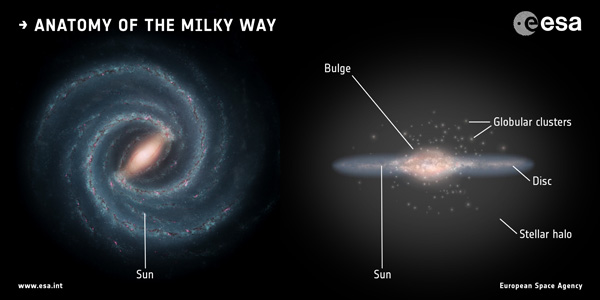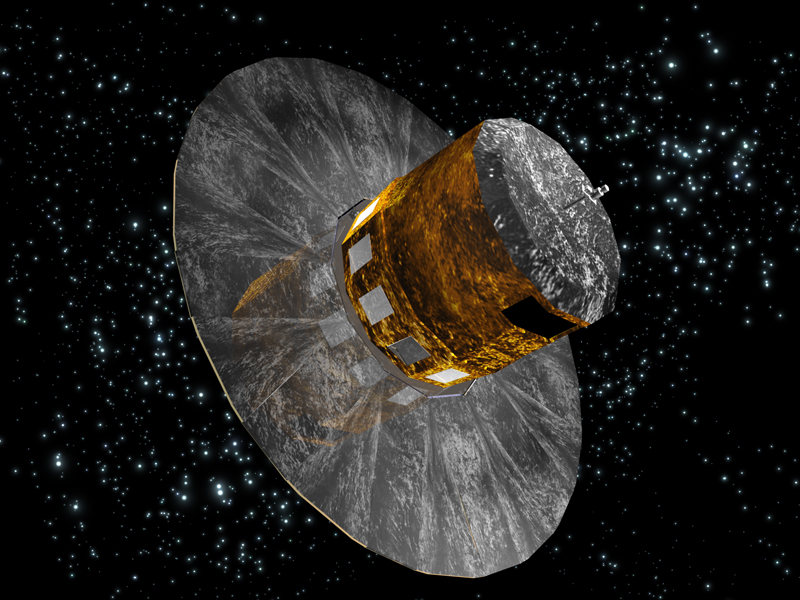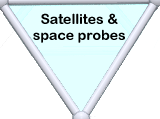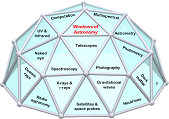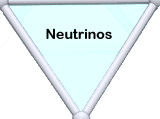Windows of Astronomy |
||
Astrometry Astrometry is the measurement of stellar location and movement. Measuring position and speed sounds like pretty rock-bottom physics. Surely it can’t get less glamorous than this - a bit like botanists mapping the location of plants or birdwatchers mapping habitats of species? I suspect that naturalists would say that such activities can be mundane but when you look at the whole picture they underpin the hugely important study of ecology. Astrometry is vital, too, for creating the picture of the universe at large and understanding why what we see is where it is now. Astrometry also turns out to be a lot harder and more sophisticated than recording flowers. Star charts show only the position of stars in the sky. Just two coordinates will locate a star. Position in space needs three coordinates, distance away being missing in star charts. Motion needs another three parameters for speed: left/right, up/down, towards/away. So, star charts capture just two of six numbers that are at the base of astrometry. If we had all six for everything we can see, we would get the structure of the universe at large and how everything is changing. That’s an aspiration we’ll not achieve. One problem is that the universe is stupendously large and even the distance to the nearest star is colossal. Stars may be moving at hundreds of km per second but no motion can be seen from day to day. They were called ‘the fixed stars’ for good reason. As we now know, no stars are fixed. The universe is a dynamic, changing place but it’s necessary to focus on the right distance and time scales. That’s where astrometry comes in. While still on fundamentals, I should say that the basis of distance measurement in science is the metre; the basis of speed measurement is the metre and the second. The astrometry I want to introduce here is measurement of position and changes that can be taken back directly to the metre and the second. There are means of estimating distance from spectroscopy and photometry that indirectly give results. These are mentioned elsewhere. People have been recording star positions for millennia, probably since the idea of making records was conceived. However, I’d date the beginnings of astrometry in the service of astronomy to the 19th century. The seafaring nations of the world encouraged astronomers to measure stellar positions accurately as a means of improving the accuracy of navigation. Astronomers and their instrument makers developed equipment that could do much better than the precision needed for navigation. They had worked out that nearby stars would appear to move relative to distant stars over a time of six months, the time it took the Earth to move its position in space to the other side of its orbit. The effect is an example of parallax. Just how big is stellar parallax? Stellar parallax is in fact too small to have been observed in the 18th century and earlier. The first person to succeed in finding a fairly reliable value was Friedrich Bessel in the 1830s. His answer was about three-quarters of a second of arc for the apparent motion of the star 61 Cygni over 6 months. The technique expands the distance scale from metre, to size of the Earth, to orbit of the Earth, to star. That is the basis of astrometry. In fact astronomical distances are often given in terms of parallax, the basic length being the radius of the Earth’s orbit, not its diameter. 1 parsec is the distance that produces a parallax of 1 second of arc. It’s actually too small a distance for any star. 100 parsecs is 100 times this distance, producing a parallax of 1/100th of a second of arc. One degree is quite a small angle and there are 3600 seconds in a degree, so measuring parallax requires the highest precision instruments.
|
Our galaxy, as deduced with the aid of astrometry. Courtesy ESA. |
|
By early 20th century there were still only a handful of observatories that could carry out astrometry and had observers with adequate skill and patience. By then only a modest number of stars had their distance measured using parallax. However, stellar motion also produces a change in the position of stars and the same accuracy of observation was sufficient to detect local motion over a time of no more than a few years. Importantly, this was motion across the field of view. Stellar motion is somewhat of a contrast to detecting position. Motion towards/away is quite easily detected by the corresponding blue shift/red shift of spectral lines. Motion across the field of view is measured by tiny changes in angle. In early 20th century the motion of some nearby stars was measured and the general rotation of the Milky Way around the galactic centre hinted at. In fact, located at the bottom of the atmosphere, one can’t really do much better in terms of accuracy than was done then. Over decades the distance scale was extended outwards, largely using photometry. Far distances remained pretty uncertain. The next big advance in astrometry needed a jump into space, which was done with ESA’s Hipparcos satellite in the early 1990s. The parallaxes and the motion of over 100,000 stars were measured to about 2 milliarcseconds. About four times that number of stars were measured to lower accuracy but very considerably better than any previous knowledge. Mankind now had a good idea of our stellar surroundings in three dimensions out to about 1000 light years away. Hipparcos was good. It revised our near distance scale and hence the accuracy of further distances. ESA’s Gaia probe is taking astrometry to a new frontier. Gaia is situated 1.5 million km from Earth, orbiting the Sun once a year looking away from the Sun. As I’m writing it is still making basic astrometric measurements (and photometric and spectroscopic measurements) on about one billion stars to an accuracy about 200 times that achieved by Hipparcos. Through Gaia we shall really know our galactic surroundings and how they are changing. We shall be able to deduce how our galaxy has picked up and assimilated other smaller galaxies, identify stars that are not participating in the general rotation of the galaxy, find the distinctive features that separate the galactic halo from the disk, and much more. Astrometry, being built on the foundation of the metre and second, is providing bedrock knowledge of our galaxy that will inform mankind indefinitely into the future.
|
Not a Hogwarts magical hat but something real and even better: the Gaia probe against a backdrop of stars. |
|
